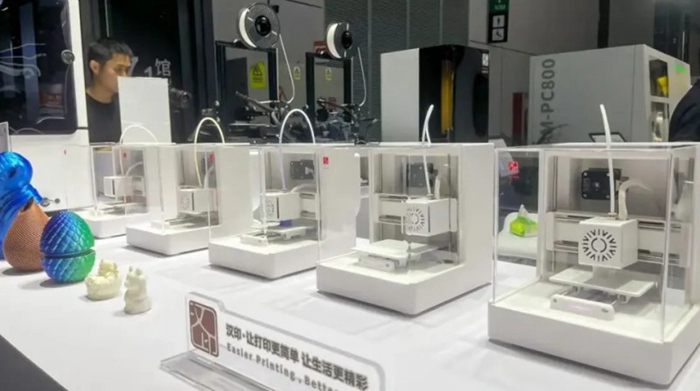
As an indispensable device in our daily life and work, digital printers have entered homes, offices, and even many professional fields. However, the high technical barriers and complex patent layout of the printer industry have deterred many domestic manufacturers. In recent years, with the continuous improvement of China's scientific and technological strength, a number of domestic printer companies have gradually broken the foreign monopoly through independent research and development, and have established international competitive advantages in fields such as intelligence and 3D printing.
1.Technical Threshold and "Patent Barriers" in the Digital Printer Industry
Printing machine involves multiple disciplines such as precision machinery, electrostatic imaging, integrated circuits, and color management, and is a veritable technology intensive industry. There are more than 100,000 valid patents related to digital printers in the world, most of which belong to companies in the United States, Japan and other developed countries. These foreign giants have firmly controlled the market by building a huge patent network and set high thresholds for other manufacturers. This means that if domestic brands want to get involved in the printer market in the early stage, they not only need to break through patent barriers, but also face high licensing fees.
In addition to patent barriers, the supply chain of the printer industry is often closed. For example, many foreign manufacturers have signed agreements with specific suppliers to ensure the monopoly of the entire chain from R&D to production. This "closed production" makes it difficult for domestic companies to purchase parts. They cannot purchase mature parts and can only rely on independent research and development. However, many parts of printers are not universal, and the cost of developing new parts is high, which increases the challenges for domestic manufacturers.

2.Breaking the Technical Threshold: Whole Printing Machine Manufacturing From Scratch
Chinese printer manufacturer did not stop because of technical barriers, but chose to face the challenges and gradually make breakthroughs in whole digital printing machine manufacturing. Pantum Electronics Co., Ltd. is a representative one among domestic brands. As early as 2010, Pantum released the first A4 laser printer with independent intellectual property rights in China, filling the technological gap in this field in China. In order to achieve this goal, Pantum started from scratch and carried out all-round independent research and development from hardware to software, from chips to data security within three years, breaking the technical barriers.
In the field of thermal printers, Hanyin Electronic Technology Co., Ltd. is also one of the early domestic manufacturers. The company quickly realized industrialization through self-developed thermal printer cores and occupied a place in the market. Subsequently, Hanyin established its own technical R&D team, gradually realized the independent design and production from printer cores to whole machines, and successively launched a number of inkjet printers with independent intellectual property rights, winning recognition in the global market.

3.Intelligence and 3D Printing: the Forefront of Industry Innovation
With the popularization of 5G communication technology and mobile Internet, consumers' demand for digital printers is becoming increasingly diversified. In response to this trend, domestic printer companies have accelerated the process of intelligence. The Pocket Photo Printer 1S of Xiaomi Smart Home is one of the representative products. This portable printer can be directly connected to the mobile phone, and users can print photos anytime and anywhere, providing consumers with a more convenient experience. In addition, Xiaomi has also launched
inkjet printer that supports mobile phone operation. It not only has multiple functions such as printing, copying, and scanning, but also enjoys low printing costs, which is deeply loved by home users and students.
In terms of intelligence, Pantum is not far behind. Pantum "Anti-hit Series" smart printer has intelligent anti-paper jam function and remote operation characteristics to meet the needs of engineering companies and large-scale office. This product is deeply integrated with a variety of Internet office applications, and users can achieve remote printing through APP no matter where they are. Pantum has tested a large number of paper characteristics under different environments, and through the optimization of special consumables and paper feeding systems, it has made the printing process more stable and smooth. The paper jam rate when printing 200,000 pages continuously is less than 0.02‰, demonstrating its high stability and durability.
In the field of 3D printing, Hanyin has also made remarkable achievements. Since 2017, Hanyin has cooperated with universities to study 3D printing technology and gradually transformed the research and development results into applicable product lines. In May, 2024, Hanyin released 5 additive manufacturing models at an international exhibition, covering different levels of industrial, commercial and consumer needs. Its SJF-P380 model printer uses advanced single solution forming technology, combined with closed-loop temperature control and digital ink drop detection technology, which effectively reduces material waste, shortens production cycles, and further improves printing accuracy and efficiency.

4.Looking to the Future: Opportunities and Challenges for Domestic Printer Brands
According to a report by iiMedia Research, the scale of China's printer market is expected to reach 40.84 billion yuan by 2025. Faced with growing consumer demand, domestic brands have a broad space for development, but they also face considerable challenges. First, with the rise of China printer companies, the technical barriers of foreign brands may be further strengthened, and global market competition will become more intense. Second, as the increasing of consumers' demand for intelligent, low-cost and multi-functional printing machines, domestic brands need to continuously increase their R&D investment to maintain the technological advantages of their products.
The innovation of domestic printer companies is not limited to breakthroughs in hardware performance. The application of new technologies such as intelligence and 3D printing is gradually leading the market development. In the future, China printer manufacturers will show greater competitiveness in the global market, and will continue to promote the advancement of printing technology, helping domestic printing equipment to occupy a more important position on the international stage.
Driven by the dual wheels of independent R&D and intelligence, the future of China printer industry is full of hope. Through technological innovation, domestic brands are gradually transforming from "followers" to "leaders" in the industry. This process not only represents the rise of Made in China in the global market, but also a strong proof of our independent innovation capabilities.
 Nov 06,2024
Nov 06,2024



